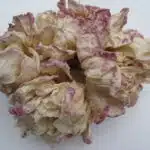Garden phlox, also known as Phlox paniculata, is a popular perennial flower that is commonly grown in gardens and landscapes. With its wide range of colors, including white, pink, purple, and red, garden phlox adds a pop of color to any garden bed. In this article, we will focus on growing ‘David’ garden phlox for white perennial flowers.
‘David’ garden phlox is a cultivar of Phlox paniculata that produces beautiful clusters of pure white flowers from mid to late summer. This variety is highly prized for its long blooming period and resistance to mildew. It has a tall upright growth habit and can reach heights of up to three feet. ‘David’ garden phlox is an excellent choice for those looking for low maintenance plants that require minimal care but provide maximum impact in the garden. In this article, we will provide tips on how to grow ‘David’ garden phlox successfully and ensure it thrives in your landscape.
What Is Garden Phlox?
Garden phlox, also known as Phlox paniculata, is a popular perennial plant that belongs to the Polemoniaceae family. This species is native to North America and can grow up to 3-4 feet tall with a width of 2-3 feet. Garden phlox plants bloom from early summer through early fall, producing beautiful clusters of white, pink, lavender, or red flowers.
There are several types of garden phlox available in the market, each with unique features and characteristics. Some popular varieties include ‘David’, ‘Bright Eyes’, and ‘Blue Paradise.’ Garden phlox plants have many benefits when added to your landscape design. They are easy to grow and care for, making them an excellent choice for novice gardeners. Additionally, they attract pollinators such as bees and butterflies to your garden.
Adding garden phlox to your landscape design not only enhances the visual appeal but also provides several environmental benefits. These plants help improve air quality by absorbing pollutants from the atmosphere. Moreover, they can reduce soil erosion by holding soil particles together with their roots. Therefore, incorporating garden phlox into your garden can be a great way to promote sustainable gardening practices while beautifying your landscape design.
As we move on to discussing ‘a brief history of David garden phlox,’ it’s essential to note that this particular variety has gained immense popularity among horticulturists due to its unique features and benefits.
A Brief History Of ‘David’ Garden Phlox
Without a doubt, ‘David’ garden phlox is a stunning white perennial flower that is highly sought after by gardeners worldwide. This cultivar of garden phlox has been around for over 60 years and has gained immense popularity due to its easy cultivation techniques and beautiful blooms. Let’s delve into the history of this plant and explore its fascinating journey.
History: ‘David’ garden phlox was first introduced in the 1950s by F.M. Mooberry, a renowned horticulturist from Indiana, USA. The plant was named after David Lavender, an American writer who had a passion for gardening. Since then, this cultivar has become one of the most popular white-flowered garden phlox varieties in North America and Europe alike.
Cultivation techniques: To grow ‘David’ garden phlox successfully, you need to follow specific cultivation techniques. Here are four tips to help you achieve success:
Soil preparation: Garden phlox prefers well-drained soil with a pH range between 6.0-7.0.
Sunlight requirements: This plant thrives in full sun to partial shade conditions.
Watering needs: Water your ‘David’ garden phlox deeply once a week or whenever the top inch of soil feels dry.
Fertilizing routine: Feed your plants with a balanced fertilizer once every month during the growing season.
Understanding the growing conditions for ‘David’ garden phlox is essential if you want to enjoy its beauty year after year. In the next section, we’ll delve deeper into these aspects and provide you with detailed information on how best to care for your plants.
Understanding The Growing Conditions For ‘David’ Garden Phlox
- ‘David’ Garden Phlox is a white perennial flower that grows best in well-drained and nutrient rich soils.
- To ensure optimal growth, ‘David’ Garden Phlox requires at least six hours of direct sunlight each day.
- Over-watering can cause root and crown rot, so the soil should be allowed to dry out between waterings.
- The soil pH should be slightly acidic, with a range of 6.0 – 7.0.
Soil Requirements
Understanding the growing conditions for ‘David’ Garden Phlox requires knowledge of its soil requirements. One important aspect to consider is the pH level of the soil. Garden phlox thrives in slightly acidic soil, with a pH range of 6.0 to 7.0. It is crucial to test the soil before planting and make necessary adjustments to achieve optimal pH levels. The importance of pH lies in its role in nutrient availability; soil that is too alkaline or acidic can hinder plant growth.
Composting is also an effective method to improve soil quality for ‘David’ Garden Phlox. Composting involves recycling organic matter such as leaves, grass clippings, and kitchen scraps which are then broken down into nutrient-rich humus. Adding compost to garden beds increases soil fertility and helps retain moisture, making it easier for plants like garden phlox to grow healthy roots and foliage. In addition, composting aids in maintaining a balanced pH level by buffering the acidity or alkalinity of the soil.
In summary, understanding ‘David’ Garden Phlox’s growing conditions require attention to its specific soil requirements including proper pH levels and adequate nutrients through composting. As horticulturists, we must recognize the importance of providing optimal growing conditions for our plants so that they can thrive and produce beautiful white flowers year after year. By incorporating these practices into our gardening routine, we can cultivate a healthy garden ecosystem that serves not only ourselves but also those around us who appreciate nature’s beauty.
Sunlight Exposure
Understanding the growing conditions for ‘David’ Garden Phlox extends beyond soil requirements. Sunlight exposure is another crucial aspect that horticulturists should pay attention to. Garden phlox prefers partial shade, which means it needs at least 4-6 hours of sunlight per day but also requires protection from intense midday sun. Benefits of partial shade include reducing water loss due to evaporation and preventing overheating of the soil, which can negatively impact plant growth. On the other hand, too much sunlight can cause wilting, sunscorch, and stunted growth in garden phlox.
To achieve optimal sunlight exposure for ‘David’ Garden Phlox, selecting an appropriate planting location is vital. Avoid areas where the plant may be exposed to long periods of direct sunlight or strong winds that can dry out the soil quickly. It’s also essential to monitor the plant regularly and adjust its position if necessary to ensure it receives adequate sunlight. By providing partial shade and avoiding excessive sun exposure, gardeners can help their ‘David’ Garden Phlox plants grow strong and healthy.
Incorporating proper sunlight exposure into our gardening routine is just as important as ensuring optimal soil conditions for ‘David’ Garden Phlox. As horticulturists, we must recognize how different environmental factors impact plant growth and adjust accordingly. By doing so, we not only cultivate beautiful gardens but also serve our communities by promoting a healthier environment filled with thriving flora.
Choosing The Right Location For ‘David’ Garden Phlox
When choosing the right location for ‘David’ Garden Phlox, it is important to consider its sun exposure requirements. This perennial plant thrives in full sun to partial shade. It can tolerate some degree of shade, but too much will reduce the number of flowers and may make the plant more susceptible to disease. Therefore, it is best to choose a location that receives at least six hours of direct sunlight per day.
Aside from sun exposure, soil requirements are also an important factor in determining the ideal location for ‘David’ Garden Phlox. This plant prefers well-draining soil that is rich in organic matter. It does not do well in heavy clay or compacted soils that do not allow for proper drainage. To ensure optimal growth and flowering, it is recommended to amend the soil with compost or other organic materials prior to planting.
By taking into account the sun exposure and soil requirements of ‘David’ Garden Phlox when choosing a planting location, gardeners can set their plants up for success. A sunny spot with well-draining soil will provide this perennial with the conditions it needs to thrive and produce an abundance of beautiful white flowers year after year. In the next section, we will discuss how to properly prepare the soil for planting ‘David’ Garden Phlox.
Preparing The Soil For Planting ‘David’ Garden Phlox
- When selecting a location for ‘David’ Garden Phlox, it is important to ensure that it receives at least six hours of direct sunlight each day.
- The soil for ‘David’ Garden Phlox should be well-draining and amended with organic matter to ensure adequate fertility.
- It is advisable to prepare the soil for ‘David’ Garden Phlox several weeks prior to planting in order to allow for any necessary amendments to take effect.
- When planting ‘David’ Garden Phlox, it is important to choose a spot that has good air circulation to avoid fungal diseases.
- Before planting ‘David’ Garden Phlox, the soil should be mixed with organic material such as compost, manure, or peat moss.
- Seeds of ‘David’ Garden Phlox should be planted in shallow furrows, and the soil should be kept moist until germination occurs.
Selecting The Location
Choosing the right spot is crucial when planting ‘David’ Garden Phlox. It is important to select a location that receives full sun or partial shade. The plant requires at least six hours of sunlight each day to thrive. Ensure that the area has well-draining soil to prevent waterlogging and root rot.
Soil preparation is an essential step in ensuring healthy growth for ‘David’ Garden Phlox. Start by removing any weeds or debris from the chosen site. Loosen the soil with a garden fork to improve drainage and air circulation. Incorporate organic matter like compost, leaf mold or aged manure into the soil to boost its fertility, texture and moisture-holding capacity.
When selecting a location for ‘David’ Garden Phlox, consider the plant’s growth habits and requirements. Choose a spot that allows sufficient space for mature plants, which can grow up to 3 feet tall and spread out about 2 feet wide. Ensure that the soil pH is between 6.0 and 7.0, which is optimal for phlox growth. By preparing the soil adequately, you will provide an ideal environment for your ‘David’ Garden Phlox to flourish beautifully year after year!
Preparing The Soil
Before planting ‘David’ Garden Phlox, it is crucial to prepare the soil properly to ensure healthy growth and development. One of the first steps in soil preparation is testing the soil’s pH level. Garden phlox grows best in soil with a pH level between 6.0 and 7.0, which is slightly acidic to neutral. You can test your soil using a home testing kit or by sending a sample to a laboratory for analysis.
Once you have determined your soil’s pH level, you can begin adding organic matter to improve its fertility, texture, and moisture-holding capacity. Organic matter can include compost, leaf mold, aged manure, or other natural materials that decompose over time and enrich the soil. Incorporating organic matter into the soil also helps improve drainage and air circulation around plant roots.
Adding organic matter to the soil is an essential step in preparing for ‘David’ Garden Phlox planting success. By improving the texture and nutrient content of your garden’s soil, you’ll create an ideal growing environment for this beautiful flowering plant that will thrive year after year with proper care and maintenance. So take the time to prepare your soil well before planting ‘David’ Garden Phlox and enjoy its stunning blooms for years to come!
Planting The Seeds
After ensuring that the soil’s pH level is within the ideal range of 6.0 to 7.0, it is time to move on to the next step in preparing for ‘David’ Garden Phlox planting – planting the seeds. When it comes to planting garden phlox seeds, there are a few growing tips and common mistakes that must be taken into consideration to ensure successful growth.
Firstly, garden phlox seeds should be planted in early spring or late fall when the soil temperature is between 60-70°F. This temperature range provides optimal conditions for germination. It is important to note that garden phlox seeds require sunlight to germinate, so they should not be buried too deeply in the soil.
Another crucial growing tip when planting garden phlox seeds is spacing. The ideal spacing between individual plants should be around 18-24 inches apart. Giving each plant enough space ensures proper air circulation and reduces the risk of disease and pests.
One common mistake made during planting is overwatering. Overwatering can lead to dampening off – a fungal disease that affects seedlings and causes them to wilt and die. Thus, it’s essential to avoid overwatering by maintaining a consistent level of moisture while allowing the soil surface to dry out slightly before watering again. In conclusion, following these growing tips and avoiding common mistakes will ensure healthy growth and development for ‘David’ Garden Phlox plants from seedlings onwards.
How To Plant ‘David’ Garden Phlox
Planting ‘David’ Garden Phlox requires attention to detail to ensure optimal growth and longevity. The first step is to choose a location with full sun exposure, well-drained soil, and good air circulation. This perennial plant thrives in an environment with a pH level between 6.0 and 8.0.
Once the location has been determined, prepare the soil by incorporating organic matter such as compost or aged manure into the top six inches of soil. Planting depth should be no deeper than the root ball of the plant. Optimal spacing for ‘David’ Garden Phlox is approximately 18-24 inches apart, allowing sufficient room for growth and airflow.
When planting ‘David’ Garden Phlox, it’s essential to take into account the height of the mature plant. Ensure that taller plants are not planted in front of shorter ones when designing your garden bed layout. Proper planting techniques will allow for a beautiful display of white flowers that bloom from June to September each year.
Transition to subsequent section: Now that you have successfully planted your ‘David’ Garden Phlox, it’s time to move on to proper watering and fertilizing techniques.
Watering And Fertilizing ‘David’ Garden Phlox
To ensure the healthy growth of ‘David’ garden phlox, proper watering and fertilizing techniques must be implemented. Summer care is crucial to maintaining the health and vibrancy of the plant during its blooming season. Adequate watering is necessary to prevent dehydration, but overwatering can lead to root rot or fungal diseases. It is recommended to water deeply once a week, especially during prolonged periods of drought.
Nutrient requirements for ‘David’ garden phlox include a balanced application of fertilizer throughout the growing season. A slow-release granular fertilizer with equal amounts of nitrogen, phosphorus, and potassium is ideal for this plant. It should be applied in early spring and again in mid-summer after the first wave of blooms has faded. Be sure to follow the manufacturer’s instructions for proper application rates.
In addition to proper watering and fertilizing techniques, pruning and deadheading ‘David’ garden phlox are essential for optimal growth and appearance. Deadheading spent flowers encourages new blooms while preventing seed production that may lead to self-seeding or invasive tendencies. Pruning back stems after flowering promotes bushier growth and prevents legginess. By properly caring for ‘David’ garden phlox, you can enjoy its beautiful white perennial flowers year after year without worrying about disease or pest problems.
Pruning And Deadheading ‘David’ Garden Phlox
- Pruning of ‘David’ Garden Phlox should be done annually in the early spring, prior to the onset of new growth.
- Deadheading should be done regularly to promote flower production and to reduce the risk of disease.
- Deadheading should be done by removing the spent flowers and dead foliage to the base of the plant.
- To prevent disease, it is important to avoid wetting the foliage when watering and to remove diseased foliage as soon as it is observed.
- Pruning and deadheading will help to keep the plants vigorous and promote a longer blooming period.
- Regularly monitoring plants for signs of disease, and pruning out any diseased foliage, will help to keep ‘David’ Garden Phlox healthy.
Pruning Frequency
Pruning is a crucial aspect of maintaining the health and appearance of ‘David’ garden phlox. The frequency of pruning greatly depends on the growth patterns of the plant. Garden phlox, including ‘David’, generally grow tall and upright, with blooms appearing at the top of each stem. As such, it is important to remove any dead or damaged stems to encourage new growth and prevent overcrowding.
One effective technique for pruning ‘David’ garden phlox is to cut back the stems by one-third in early spring before new growth appears. This will help to promote bushier growth and more abundant blooms later in the season. Additionally, deadheading spent blooms throughout the growing season will encourage continued blooming and prevent seed production.
The frequency of pruning for ‘David’ garden phlox can also be influenced by environmental factors such as climate and soil conditions. In areas with hot summers, regular pruning may be necessary to prevent wilting or heat stress. Likewise, in nutrient-poor soils, more frequent pruning may be needed to maintain healthy growth. By understanding the unique growth patterns of ‘David’ garden phlox and adapting pruning techniques accordingly, gardeners can enjoy beautiful white perennial flowers year after year.
Deadheading Tips
In addition to pruning, deadheading is another essential technique for maintaining the health and appearance of ‘David’ garden phlox. Deadheading refers to removing spent flowers from the plant, which can provide numerous benefits. Firstly, deadheading can encourage continued blooming throughout the growing season by redirecting the plant’s energy towards producing new flowers rather than seed production. This can result in a more abundant and prolonged display of beautiful white blooms.
Timing for deadheading is crucial when it comes to ‘David’ garden phlox. It is recommended to deadhead as soon as the flowers start to fade and wilt. This will prevent the plant from wasting energy on producing seeds and instead encourage it to put its resources towards creating new blooms. Additionally, regular deadheading will help to maintain a neat and tidy appearance for the plant by preventing it from becoming cluttered with unsightly brown or wilted flowers.
Overall, incorporating deadheading into your maintenance routine for ‘David’ garden phlox can help enhance its beauty and health. By removing spent blooms at the right time, you can promote continued blooming throughout the season while keeping the plant looking attractive and tidy. With these tips in mind, you’ll be able to enjoy an eye-catching display of white perennial flowers in your garden year after year.
Disease Prevention
Preventive measures are crucial in maintaining the health and vitality of ‘David’ garden phlox. As with any plant, disease prevention is better than cure. Gardeners can take several steps to prevent diseases from affecting their plants, including choosing a suitable location that provides adequate sunlight and air circulation and avoiding overcrowding. Additionally, regular watering, fertilization, and soil maintenance can help keep the plant healthy and resistant to disease.
Early detection is also essential in preventing the spread of diseases in ‘David’ garden phlox. It is recommended to inspect the plant regularly for any signs of disease, such as discoloration, wilting leaves or stems, or unusual growth patterns. If symptoms are detected early on, it may be possible to treat them before they spread further. Prompt action can help prevent the loss of the entire plant or even an entire garden bed.
In summary, taking preventive measures and practicing early detection are key factors in preserving the health of ‘David’ garden phlox. By following these guidelines, gardeners can ensure that their plants remain healthy and beautiful for years to come. Remember that prevention is always better than cure when it comes to protecting your precious plants from diseases!
Common Pests And Diseases Of ‘David’ Garden Phlox
After pruning and deadheading ‘David’ garden phlox, it is important to be aware of common pests and diseases that can affect this plant. Prevention and treatment are key in maintaining the health and beauty of your garden phlox. By being proactive, you can avoid the spread of disease and damage caused by pests.
One common pest that affects ‘David’ garden phlox is the spider mite. These tiny insects feed on the plant’s sap, causing leaves to yellow and eventually die off. Regularly inspecting your plants for signs of spider mites is crucial in catching an infestation early. Treatment options include using insecticidal soap, neem oil, or horticultural oil.
Another pest to watch out for is the powdery mildew fungus. This appears as a white powdery substance on the leaves of the plant and can spread quickly, especially during periods of high humidity. To prevent powdery mildew, avoid overhead watering and make sure there is good air circulation around your plants. If caught early, natural remedies such as spraying a mixture of baking soda and water onto affected leaves can help control its spread.
In conclusion, keeping an eye out for common pests and diseases that affect ‘David’ garden phlox can save you time and energy in maintaining your plants. Early detection is key in preventing further damage from occurring. By utilizing natural remedies to combat these issues, you can maintain healthy plants without relying on harsh chemicals or pesticides. In our next section, we will explore tips for maintaining healthy ‘David’ garden phlox throughout the growing season.
Tips For Maintaining Healthy ‘David’ Garden Phlox
To maintain healthy ‘David’ Garden Phlox, it is important to take preventive measures against pests and diseases. One of the most common pests that can affect these plants are spider mites. To prevent infestations, keep the soil moist and avoid overhead watering. Additionally, avoid overcrowding the plants as this can lead to poor air circulation and increase the risk of disease. If necessary, apply an insecticide or fungicide according to label instructions.
Maximizing bloom time for ‘David’ Garden Phlox requires proper fertilization and deadheading techniques. Choose a fertilizer with a higher ratio of phosphorus, which promotes flower production. Apply fertilizer in early spring before new growth appears and again after the first blooms have faded. Deadheading spent flowers regularly will encourage new blooms to form throughout the growing season.
Choosing the right fertilizer for ‘David’ Garden Phlox is essential for maintaining healthy growth and vibrant blooms. In addition to phosphorus-rich fertilizers, consider using organic options such as compost or well-rotted manure. These natural fertilizers provide essential nutrients without harsh chemicals that can harm beneficial soil organisms. Proper deadheading techniques should also be used to remove spent blooms regularly, which encourages new growth and prolongs bloom time.
###Tips for Maintaining Healthy ‘David’ Garden Phlox
- Preventing pests:
- Keep soil moist
- Avoid overcrowding plants
- Apply insecticide/fungicide if necessary
- Maximizing bloom time:
- Choose fertilizer with high phosphorus ratio
- Apply fertilizer in early spring & after first blooms fade
- Regularly deadhead spent flowers
In the next section, we will discuss companion plants for ‘David’ Garden Phlox that can help enhance its beauty in your garden space. By incorporating these tips into your gardening routine, you’ll be able to enjoy healthy and vibrant ‘David’ Garden Phlox year after year!
Companion Plants For ‘David’ Garden Phlox
Maintaining healthy ‘David’ garden phlox may be a challenge, but it is worth it when the beautiful white flowers bloom. Now that you have learned how to care for them properly, it’s time to think about companions that will complement their beauty.
When choosing companion plants for ‘David’ garden phlox, it’s essential to consider the colors and textures of the other plants. They should not overpower or overshadow the phlox. Some of the best companions are low-growing sedums, salvias, and daylilies. The sedums provide a contrasting texture with their succulent leaves, while the salvias and daylilies offer pops of color that work well with white flowers.
Design tips for planting ‘David’ garden phlox in your garden include planting them in groups of 3-5 for a more impactful display. Space them 18-24 inches apart so they have enough room to grow and spread out. For a more natural look, mix different varieties of phlox together or plant them alongside other tall perennials such as coneflowers or black-eyed susans.
As you plan your garden layout, keep in mind that propagating ‘David’ garden phlox can be done through division or cuttings in early spring before new growth emerges. This will allow you to expand your phlox collection or share it with others who admire their beauty. With these tips in mind, your ‘David’ garden phlox will thrive and make your garden a beautiful oasis for all to enjoy.
Propagating ‘David’ Garden Phlox
Propagating ‘David’ Garden Phlox from cuttings is one of the most efficient methods of propagating this perennial flower species, as it requires minimal resources and allows for the production of many plants from one mother plant.
Cuttings should be taken from healthy, disease-free mother plants in late summer or early fall.
Starting ‘David’ Garden Phlox from seed is a more labor intensive method of propagation, but can be achieved by sowing seeds indoors in late winter and then transplanting them outdoors in the spring.
It is important to note that seeds should be sown in sterile soil and should not be exposed to temperatures below 50 degrees Fahrenheit.
Propagating From Cuttings
Propagating ‘David’ Garden Phlox is an important skill for any horticulturist. The process of propagating from cuttings is a reliable technique that can help you grow more phlox plants with ease. Before starting, it is important to have a good understanding of the best practices for propagating this plant.
To propagate ‘David’ Garden Phlox, take cuttings in the late spring or early summer when the plant is actively growing. Cut 4-6 inch stems from healthy plants and remove the bottom leaves. Dip the cut end of the stem into rooting hormone and place it in well-draining soil mix. Keep the soil moist and provide adequate light until roots develop, which usually takes 2-3 weeks.
It is important to keep in mind that not all cuttings will root successfully, so it is recommended to take several cuttings at once to increase your chances of success. Once rooted, transplant the new plants to their permanent location in your garden or container. With these growing techniques and best practices, you can easily propagate ‘David’ Garden Phlox and enjoy its beautiful white perennial flowers year after year.
Starting From Seed
To further propagate ‘David’ Garden Phlox, starting from seed is another viable option for horticulturists. Starting from seed allows you to grow a large number of new plants at once, and it is a cost-effective way to expand your garden or start a new one. When starting from seed, the first step is to collect seeds from mature plants in the late summer or early fall. The collected seeds must be cleaned and stored in a cool, dry place until the following spring.
To start the seeds, sow them indoors six to eight weeks before the last frost date in your area. Use well-draining soil mix and keep the soil moist while placing the container in an area with adequate light. After germination, ensure that each seedling receives enough light and water but avoid overwatering as this could cause root rot. Once the risk of frost has passed in your region, transplant the seedlings outside into their permanent location.
Seedling care is important during their initial growth stages as it determines how well they will thrive later on. It’s essential to monitor their growth regularly and provide them with enough nutrients by using fertilizers sparingly. By starting ‘David’ Garden Phlox from seed, you can enjoy more of its beautiful white flowers while saving money and expanding your garden space significantly.
Using ‘David’ Garden Phlox In Floral Arrangements
The delicate white flowers of ‘David’ Garden Phlox make for an elegant addition to any floral arrangement. These perennials can be harvested in the summer months when they are in full bloom. Proper harvesting techniques include selecting stems with fully open buds and cutting them at a 45-degree angle before placing them immediately into water.
Arranging techniques for ‘David’ Garden Phlox vary depending on the desired aesthetic. For a simple yet stunning look, arrange the phlox in a vase with other white blooms such as lilies or hydrangeas. For a more colorful arrangement, mix pink or purple blooms with the white phlox to create a vibrant contrast. To add texture, consider incorporating greenery such as eucalyptus or ferns.
When using ‘David’ Garden Phlox in arrangements, it is important to note their vase life. With proper care and maintenance, these flowers can last up to two weeks in water. To extend their lifespan, change the water every two days and trim the stems at an angle each time. Additionally, keep them away from direct sunlight and drafts to prevent premature wilting.
- Experiment with different vase shapes and sizes to create unique arrangements
- Incorporate ‘David’ Garden Phlox into bridal bouquets for a timeless look
- Pair white phlox with yellow or orange blooms for a cheerful summer arrangement
Moving forward, it is important to understand how to properly care for ‘David’ Garden Phlox both before and after harvest to ensure longevity in arrangements. In order to do this, many people have questions about planting and maintaining these perennials. Read on for frequently asked questions about ‘David’ Garden Phlox.
Frequently Asked Questions About ‘David’ Garden Phlox
When it comes to perennial flowers, ‘David’ garden phlox is a true standout. Its pure white blooms are simply stunning and can add a touch of elegance to any landscape. But the benefits of this plant go beyond just its aesthetic qualities. In fact, ‘David’ garden phlox is known for its ability to attract pollinators like bees and butterflies, making it an excellent choice for companion planting.
One common misconception about garden phlox is that it requires a lot of maintenance. However, this couldn’t be further from the truth. ‘David’ garden phlox is actually quite easy to care for and can thrive in a variety of soil types and light conditions. With proper watering and occasional fertilization, this plant can continue to bloom year after year without much effort on your part.
Benefits of companion planting aside, ‘David’ garden phlox is truly a beautiful addition to any landscape. Its tall, slender stems and delicate blooms make it an eye-catching focal point in any garden bed or border. And with its ability to attract beneficial pollinators, you’ll not only be adding beauty but also helping to support the ecosystem around you. So why not consider adding ‘David’ garden phlox to your own landscape? You won’t regret it!
Transitioning into the subsequent section about conclusion: enjoying the beauty of ‘david’ garden phlox in your landscape, one cannot help but feel excited about the possibilities that await them when they add this stunning plant to their gardens. Not only will you be able to enjoy its elegant white blooms year after year, but you’ll also be supporting local pollinators and contributing to a healthier ecosystem overall. So what are you waiting for? Add ‘David’ garden phlox to your gardening plans today and experience all that this amazing plant has to offer!
Conclusion: Enjoying The Beauty Of ‘David’ Garden Phlox In Your Landscape
As we have learned from the previous section, ‘David’ garden phlox is a popular perennial flower with white blooms that can add beauty to any landscape design. When planning your garden, consider incorporating this plant to create a fresh and vibrant look. Here are some landscape design ideas featuring ‘David’ garden phlox:
Use it as a border plant: Plant ‘David’ garden phlox along the edge of your garden bed to create a crisp and clean border. Its pure white flowers will contrast beautifully with other colorful perennials.
Create a monochromatic theme: Pair ‘David’ garden phlox with other white-flowering plants such as daisies or lilies to create a stunning monochromatic display in your garden.
Combine with foliage plants: The green foliage of ‘David’ garden phlox can be accentuated when paired with darker-leaved plants like heuchera or hostas.
Add height to your garden: Plant ‘David’ garden phlox towards the back of your flower bed for added height and dimension in your landscape design.
Aside from its aesthetic value, growing ‘David’ garden phlox also provides benefits for pollinators. As an excellent nectar source, this plant attracts bees, butterflies, and hummingbirds, making it an essential addition to any pollinator-friendly garden.
Incorporating ‘David’ garden phlox into your landscape not only adds beauty but also serves as a contribution to the environment by supporting pollinators. By providing these creatures with nectar sources, you are helping maintain biodiversity in our ecosystem while enjoying the beauty of this lovely perennial flower in your own backyard.
Conclusion
Garden Phlox, also known as Phlox paniculata, is a popular perennial flower that is commonly found in gardens across North America. One of the most prized varieties of Garden Phlox is ‘David’, which features pure white flowers that bloom in mid-summer to early fall. This beautiful plant is a must-have for any garden enthusiast who wants to add a touch of elegance and sophistication to their landscape.
‘David’ Garden Phlox has a rich history that dates back to the 1700s when it was first introduced into cultivation by European botanists. Since then, this hardy plant has undergone numerous transformations and is now one of the most sought-after garden perennials in the world.
To grow ‘David’ Garden Phlox successfully, it’s essential to understand its growing conditions. This plant thrives in moist, well-drained soil and prefers full sun exposure. It’s also crucial to choose the right location for planting and prepare the soil adequately before planting.
Propagation of ‘David’ Garden Phlox can be done using stem cuttings or division of mature plants. Once established, this hardy perennial requires little care other than regular watering and occasional fertilization.
In conclusion, ‘David’ Garden Phlox is an excellent choice for anyone looking to add a touch of elegance and sophistication to their garden landscape. Its pure white flowers are stunningly beautiful and perfect for use in floral arrangements or as a focal point in any garden setting. By following the simple guidelines outlined here, you can enjoy the beauty of ‘David’ Garden Phlox for years to come. So why not add this magnificent plant to your garden today?
Image Credits
- “phlox flower with dew, sooc” by Martin LaBar (featured)





























